Multipulse Ballistic Injection: A Novel Method for Improving Low Temperature Combustion with Early Injection Timings
Abstract
:1. Introduction
1.1. The LTC Concept
1.2. The State-of-the-Art of LTC
1.3. State-of-the-Art Multipulse Injection Strategies
1.4. The Applied MBI Strategy
2. Experimental Apparatus and Methods
2.1. Experimental Engine and Apparatus
2.2. Experimental Methods
3. Results and Discussion
3.1. First Experiment
3.2. Second Experiment
3.3. The Applicability of MBI
4. Conclusions
- The heat release of MBI is higher than a single injection with the same amount of injected fuel. Owing to this rise, higher IMEP and indicated thermal efficiency is acquired. The calculated maximal thermal efficiency increased to 46% from 37%. The increased temperature and rate of pressure rise also indicates advanced burning conditions. The outcome reveals the enhanced air–fuel mixing property of the MBI.
- The reduction in heat release while advancing CoI was less in the case of MBI. The minimum heat release of the 0.2 ms × 15 MBI structure was 58% of this case’s maximal heat release, while the single injection’s minimal value was only 18%. This means a worse combustion at early single injections. The investigated HRRs also showed that the MBI combustion is superior at early injection timings. This is clear evidence for the wall-impingement-decreasing potential of MBI.
- The EGR had the expected effects on the MBI. It retarded and prolonged the combustion, lowered the pressure gradient, the temperature, and the NOx emission. This is the same behavior that can be read in the literature of LTC engines. The EGR increased the PM emission, so a compromise is necessary.
- The disadvantage of the MBI is the prolonged injection duration. This avoids the application of the method at injection timings close to TDCF, where the IMEP is the highest. There the long injection hangs into the combustion, which results in a diffusion flame, loss in mixture homogeneity, and increased PM emission. The solution for this problem could be the use of Continuous ballistic injection, which applies only one ballistic injection. This could result a shorter injection duration with the remaining advantages of the ballistic region.
Author Contributions
Funding
Conflicts of Interest
Abbreviations
References
- Singh, A.P.; Agarwal, A.K. Low-Temperature Combustion: An Advanced Technology for Internal Combustion Engines; Springer Nature Singapore Pte Ltd.: Singapore, 2018. [Google Scholar]
- Ya, B. The oxidation of nitrogen in combustion and explosions. Acta Physicochim. URSS 1946, 21, 557. [Google Scholar]
- Bendu, H.; Murugan, S. Homogeneous charge compression ignition (HCCI) combustion: Mixture preparation and control strategies in diesel engines. Renew. Sustain. Energy Rev. 2014, 38, 732–746. [Google Scholar] [CrossRef]
- Agarwal, A.K.; Singh, A.P.; Maurya, R.K. Evolution, challenges and path forward for low temperature combustion engines. Prog. Energy Combust. Sci. 2017, 61, 1–5. [Google Scholar] [CrossRef]
- Yao, M.; Zheng, Z.; Liu, H. Progress and recent trends in homogeneous charge compression ignition (HCCI) engines. Prog. Energy Combust. Sci. 2009, 35, 398–437. [Google Scholar] [CrossRef]
- Yang, J. Expanding the operating range of homogeneous charge compression ignition spark ignition dual mode engines in the homogeneous charge compression ignition mode. Int. J. Engine Res. 2005, 6, 279–288. [Google Scholar] [CrossRef]
- Thrlng, R.H. Homogeneous-Charge Compression Ignition (HCCI) Engines; SAE Technical Papers; SAE International: Warrendale, PL, USA, 1989. [Google Scholar]
- Park, S.W.; Reitz, R.D. Numerical study on the low emission window of homogeneous charge compression ignition diesel combustion. Combust. Sci. Technol. 2007, 179, 2279–2307. [Google Scholar] [CrossRef]
- Hardy, W.L.; Reitz, R.D. A Study of the Effects of High EGR, High Equivalence Ratio, and Mixing Time on Emissions Levels in a Heavy-Duty Diesel Engine for PCCI Combustion; SAE Technical Papers; SAE International: Warrendale, PL, USA, 2006. [Google Scholar]
- Mazda’s New Skyactiv-X Engine Gives New Life to Internal Combustion. IEEE Spectr. 2018. Available online: https://spectrum.ieee.org/transportation/efficiency/mazdas-new-skyactivx-engine-gives-new-life-to-internal-combustion (accessed on 2 May 2020).
- Li, J.; Yang, W.; Zhoub, D. Review on the management of RCCI engines. Renew. Sustain. Energy Rev. 2017, 69, 65–79. [Google Scholar] [CrossRef]
- Boldaji, M.R.; Sofianopoulos, A.; Mamalis, S.; Lawler, B. Effects of Mass, Pressure, and Timing of Injection on the Efficiency and Emissions Characteristics of TSCI Combustion with Direct Water Injection; SAE Technical Papers; SAE International: Warrendale, PL, USA, 2018. [Google Scholar]
- Walter, B.; Gatellier, B. Near zero NOx emissions and high fuel efficiency diesel engine: The NADI concept using dual mode combustion. Oil Gas Sci. Technol. Rev. IFP 2003, 58, 101–114. [Google Scholar] [CrossRef]
- Kimura, S.; Aoki, O.; Ogawa, H.; Muranaka, S.; Enomoto, Y. New Combustion Concept for Ultra-Clean and High-Efficiency Small DI Diesel Engines; SAE Technical Papers; SAE International: Warrendale, PL, USA, 1999. [Google Scholar]
- Zeng, W.; Xie, M. A novel approach to reduce hydrocarbon emissions from the HCCI engine. Chem. Eng. J. 2008, 139, 380–389. [Google Scholar] [CrossRef]
- Park, S.H.; Yoon, S.H.; Lee, C.S. Effects of multiple-injection strategies on overall spray behavior, combustion, and emissions reduction characteristics of biodiesel fuel. Appl. Energy 2010, 88, 88–98. [Google Scholar] [CrossRef]
- Mendez, S.; Thirouard, B. Using multiple injection strategies in diesel combustion: Potential to improve emissions, noise and fuel economy trade-off in low cr engines. SAE Int. J. Fuels Lubr. 2008, 1, 662–674. [Google Scholar] [CrossRef]
- O’Connor, J.; Musculus, M. Post injections for soot reduction in diesel engines: A review of current understanding. SAE Int. J. Engines 2013, 6, 400–421. [Google Scholar] [CrossRef] [Green Version]
- Jörg, C.; Schnorbus, T.; Jarvis, S.; Neaves, B.; Bandila, K.; Neumann, D. Feedforward control approach for digital combustion rate shaping realizing predefined combustion processes. SAE Int. J. Engines 2015, 8, 1041–1054. [Google Scholar] [CrossRef]
- Scafati, F.T.; Pirozzi, F.; Montanaro, A.; Allocca, L. Real Time Control of GDI Fuel Injection during Ballistic Operation Mode; SAE Technical Papers; SAE International: Warrendale, PL, USA, 2015. [Google Scholar]
- Payri, R.; de la Morena, J.; Pagano, V.; Hussain, A.; Sammut, G.; Smith, L. One-dimensional modeling of the interaction between close-coupled injection events for a ballistic solenoid injector. Int. J. Engine Res. 2019, 20, 452–469. [Google Scholar] [CrossRef]
- Vass, S.; Zöldy, M. Detailed model of a common rail injector. Acta Univ. Sapientiae Electr. Mech. Eng. 2019, 11, 22–33. [Google Scholar] [CrossRef] [Green Version]
- Mei, D.; Yue, S.; Zhao, X.; Hielscher, K.; Baar, R. Effects of center of heat release on combustion and emissions in a PCCI diesel engine fuelled by DMC-diesel blend. Appl. Therm. Eng. 2017, 114, 969–976. [Google Scholar] [CrossRef]
- Yao, M.; Zhang, B.; Zheng, Z.; Chen, Z.; Xing, Y. Effects of exhaust gas recirculation on combustion and emissions of a homogeneous charge compression ignition engine fuelled with primary reference fuels. Proc. Inst. Mech. Eng. Part D J. Automob. Eng. 2007, 221, 197–213. [Google Scholar] [CrossRef]
- Yap, D.; Karlovsky, J.; Megaritis, A.; Wyszynski, M.L.; Xu, H. An investigation into propane homogeneous charge compression ignition (HCCI) engine operation with residual gas trapping. Fuel 2005, 84, 2372–2379. [Google Scholar] [CrossRef]
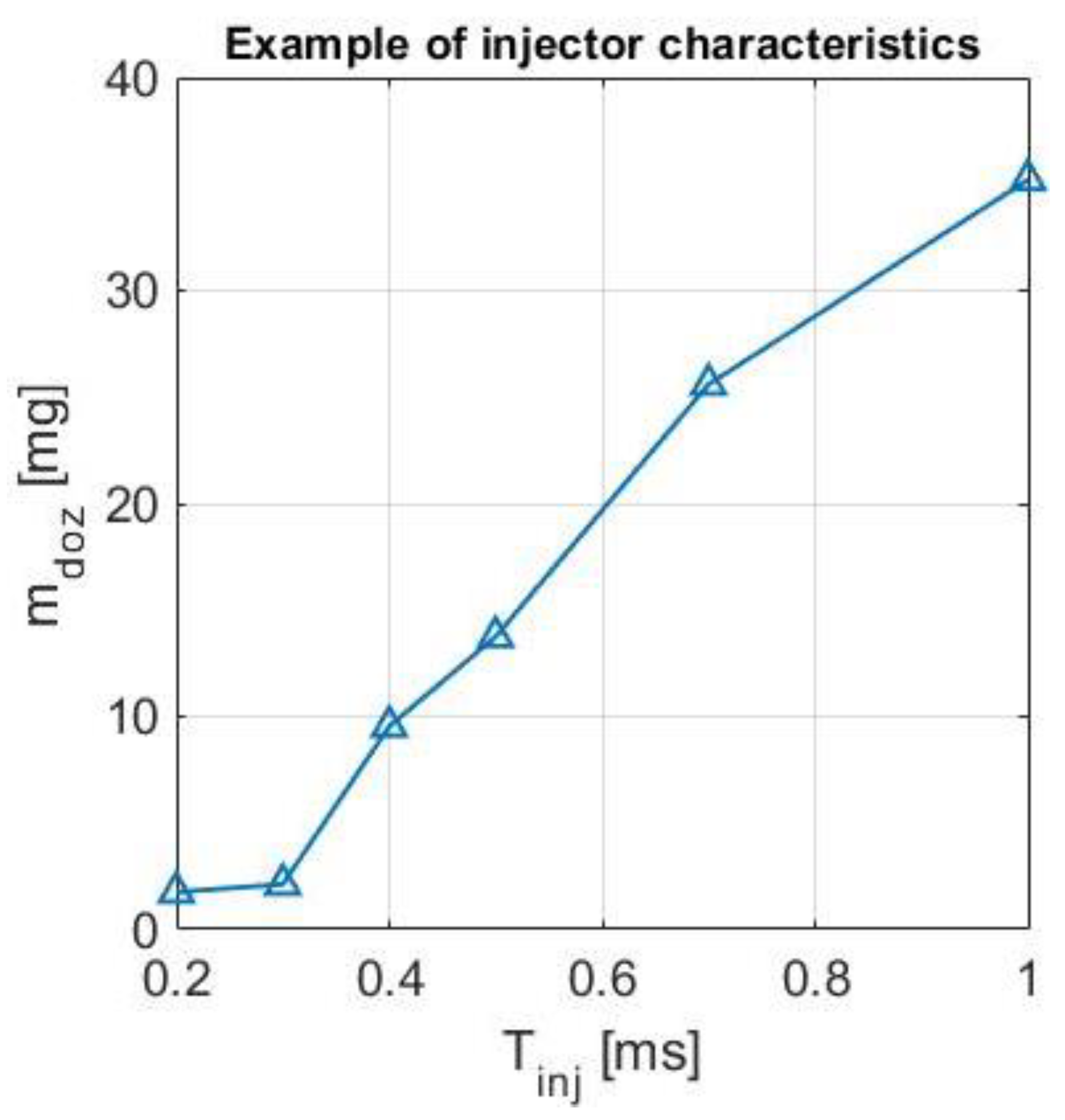
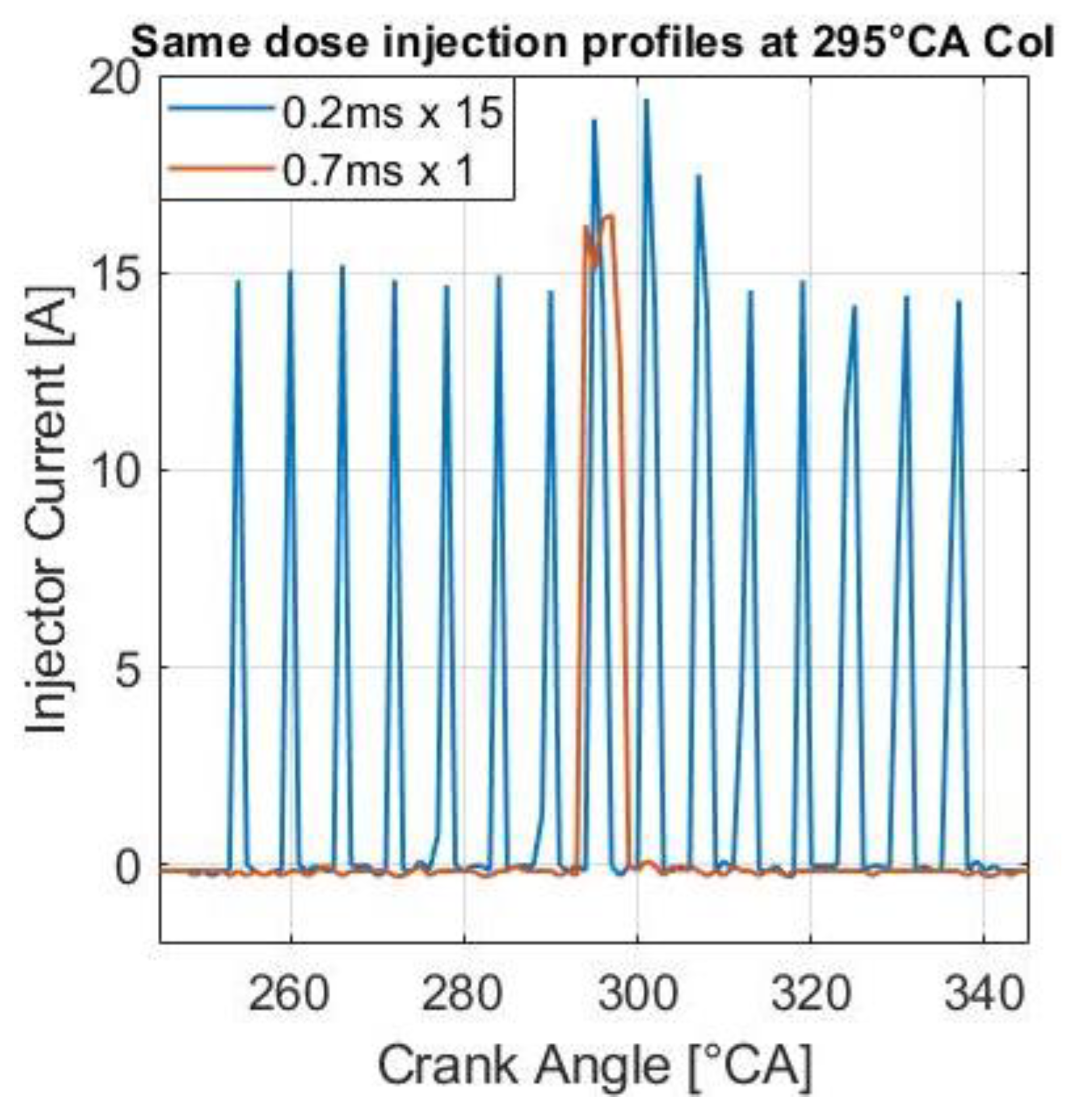


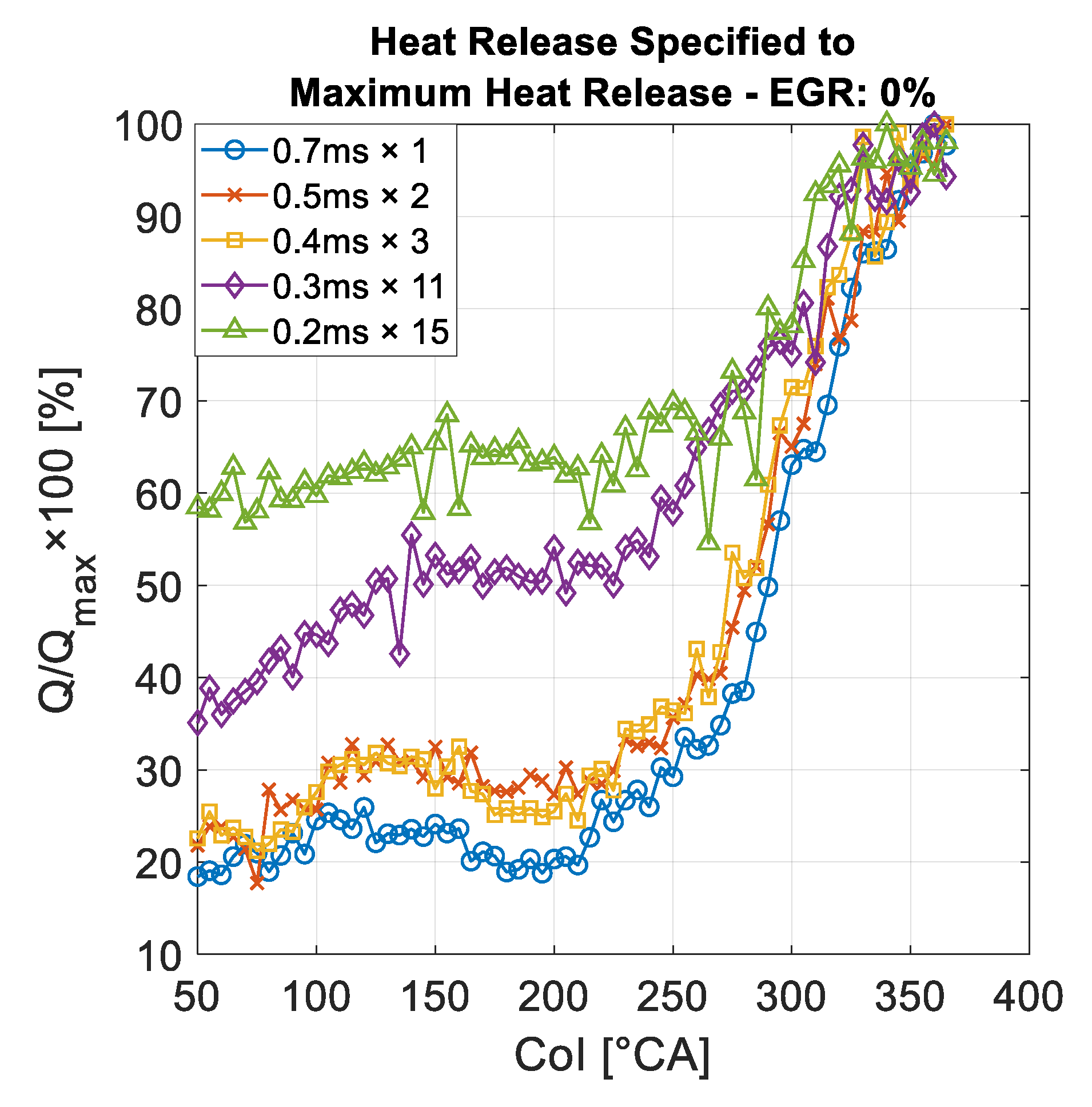

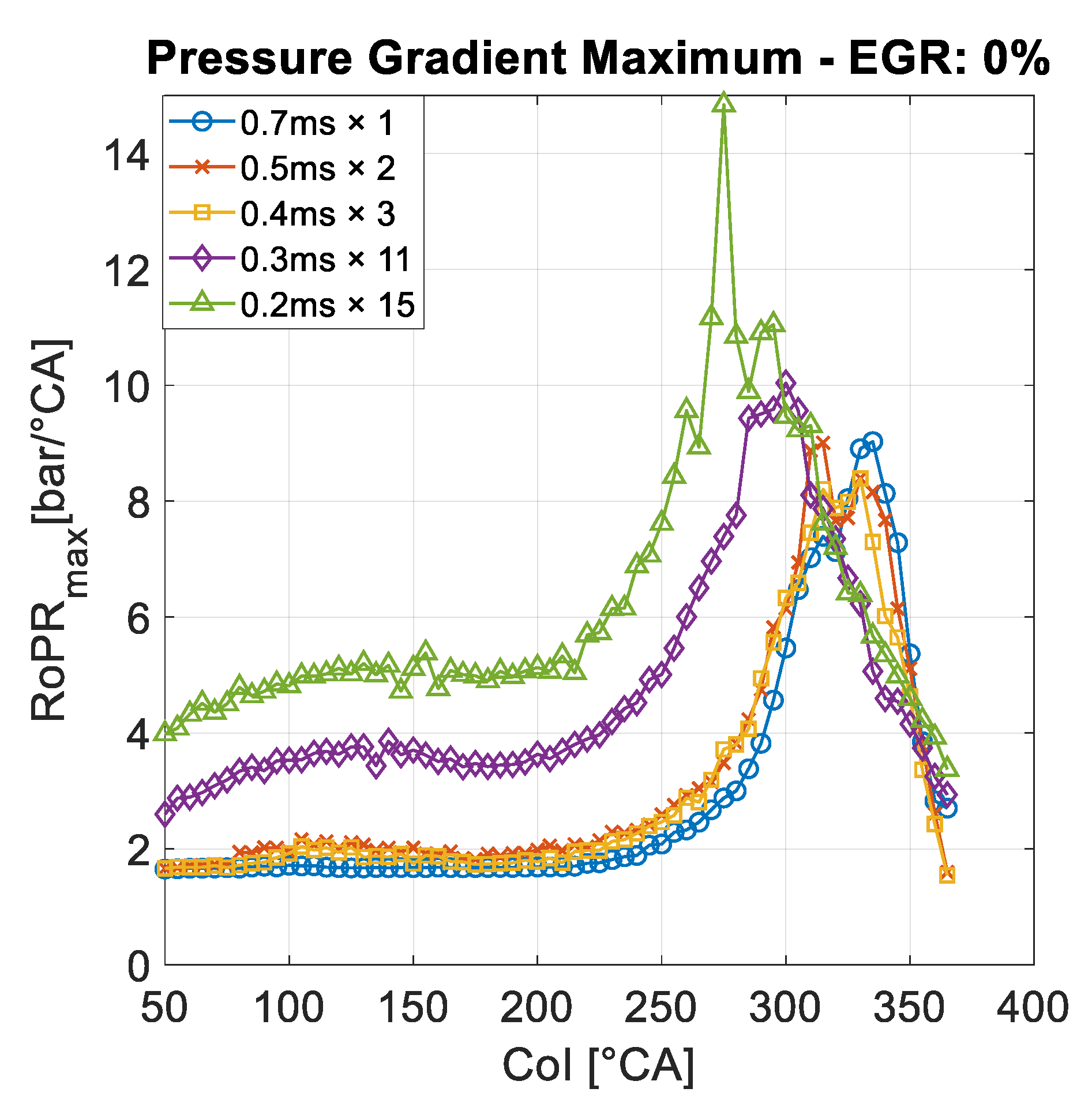

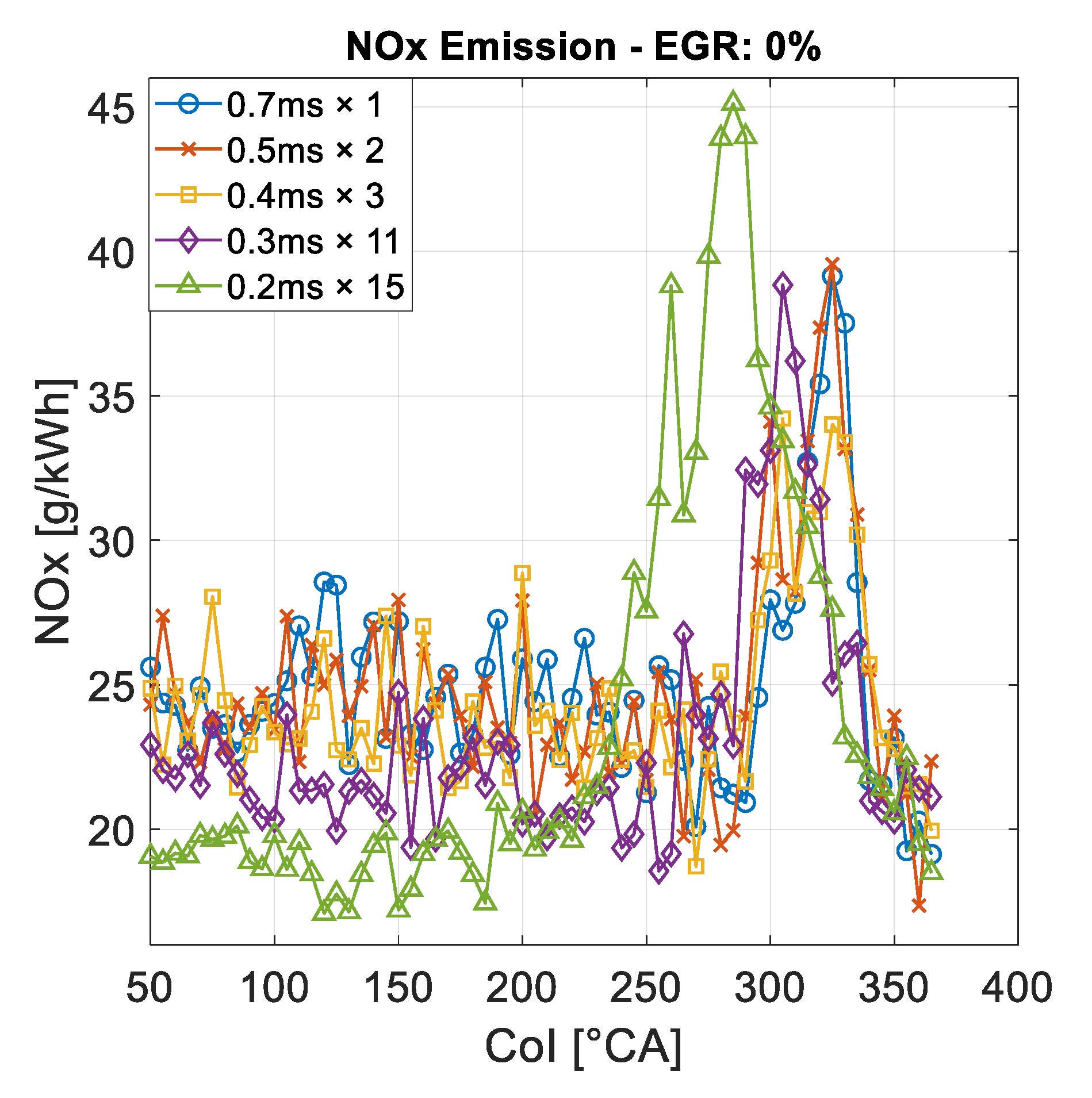
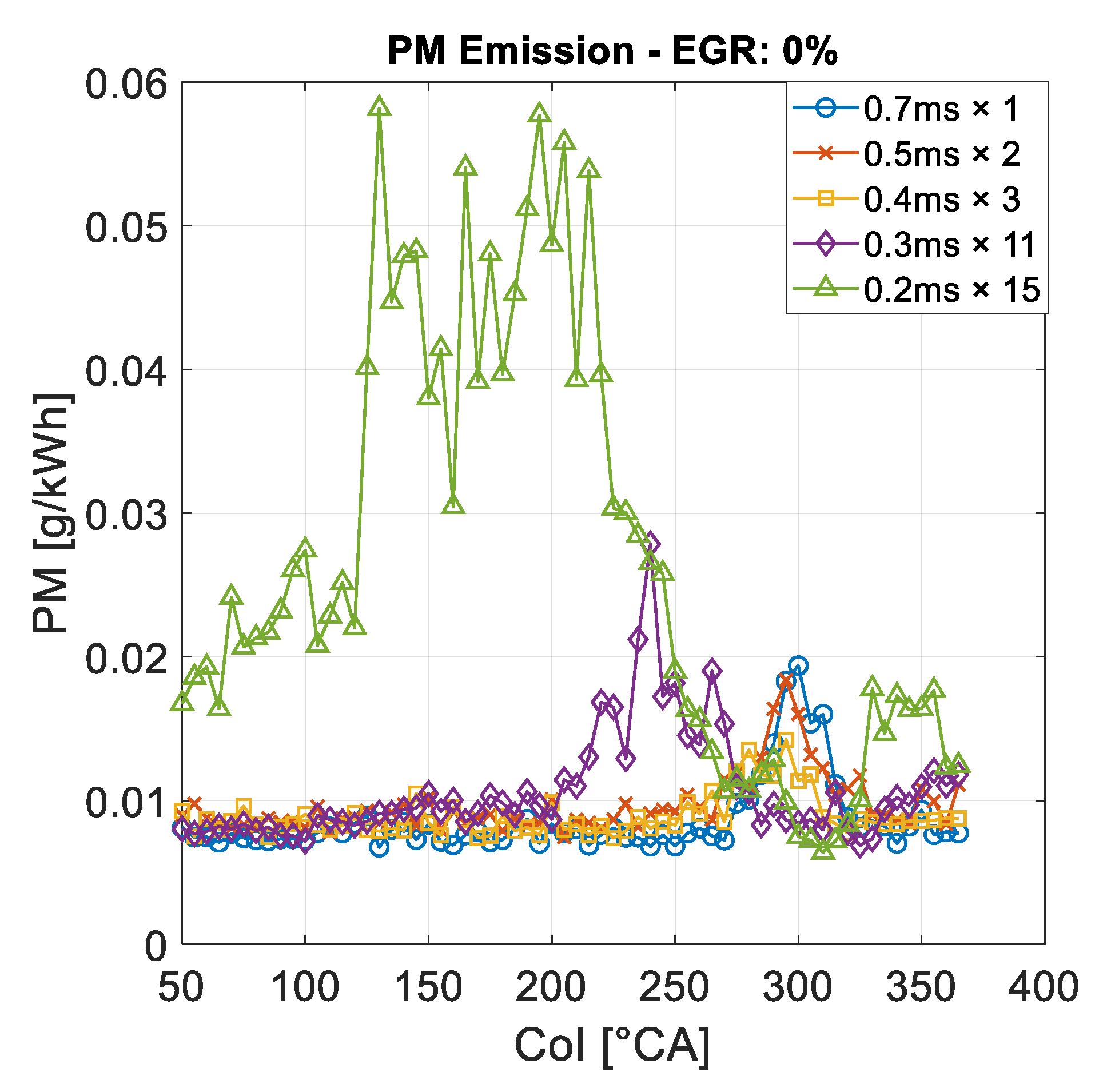
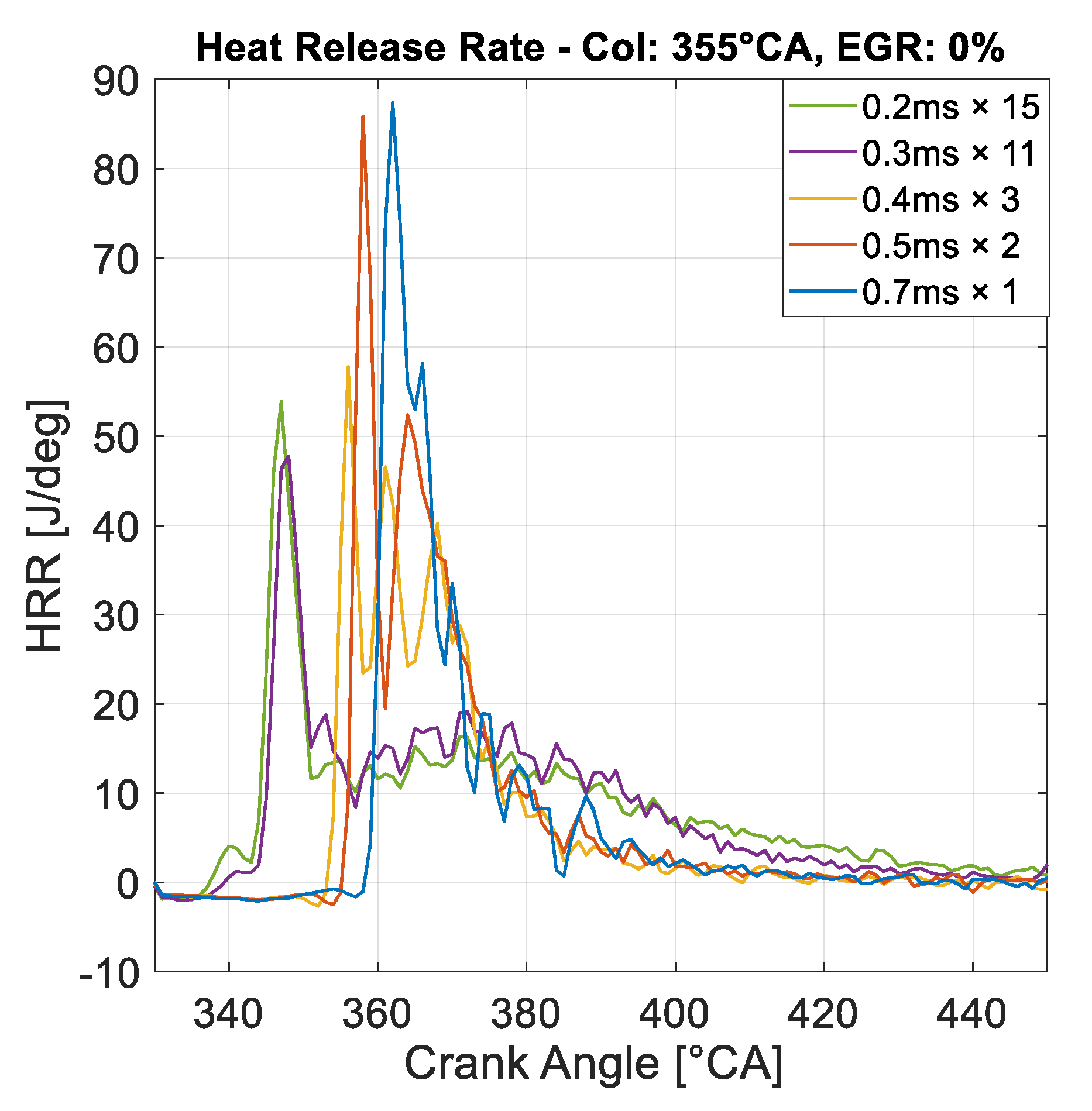
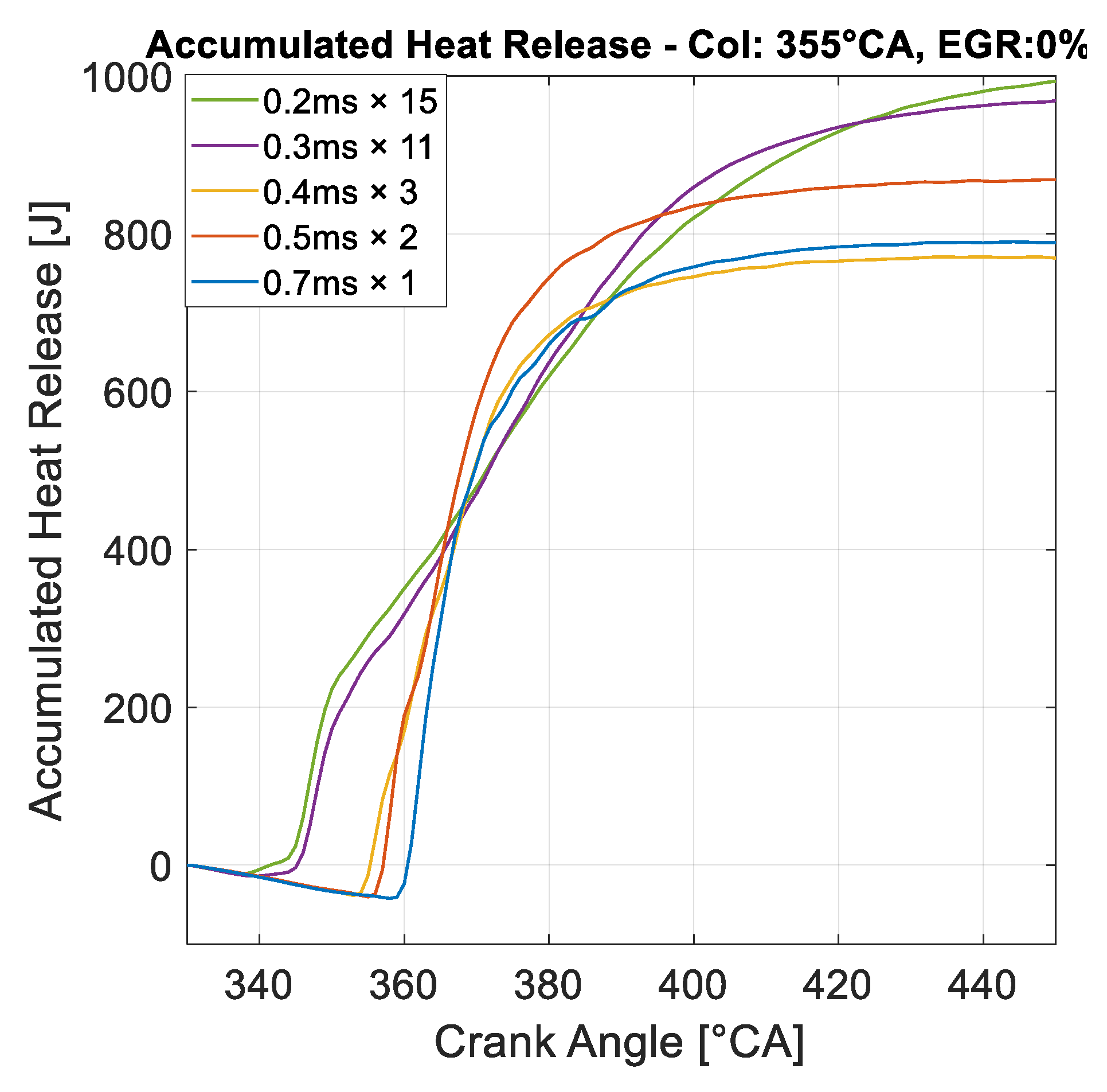
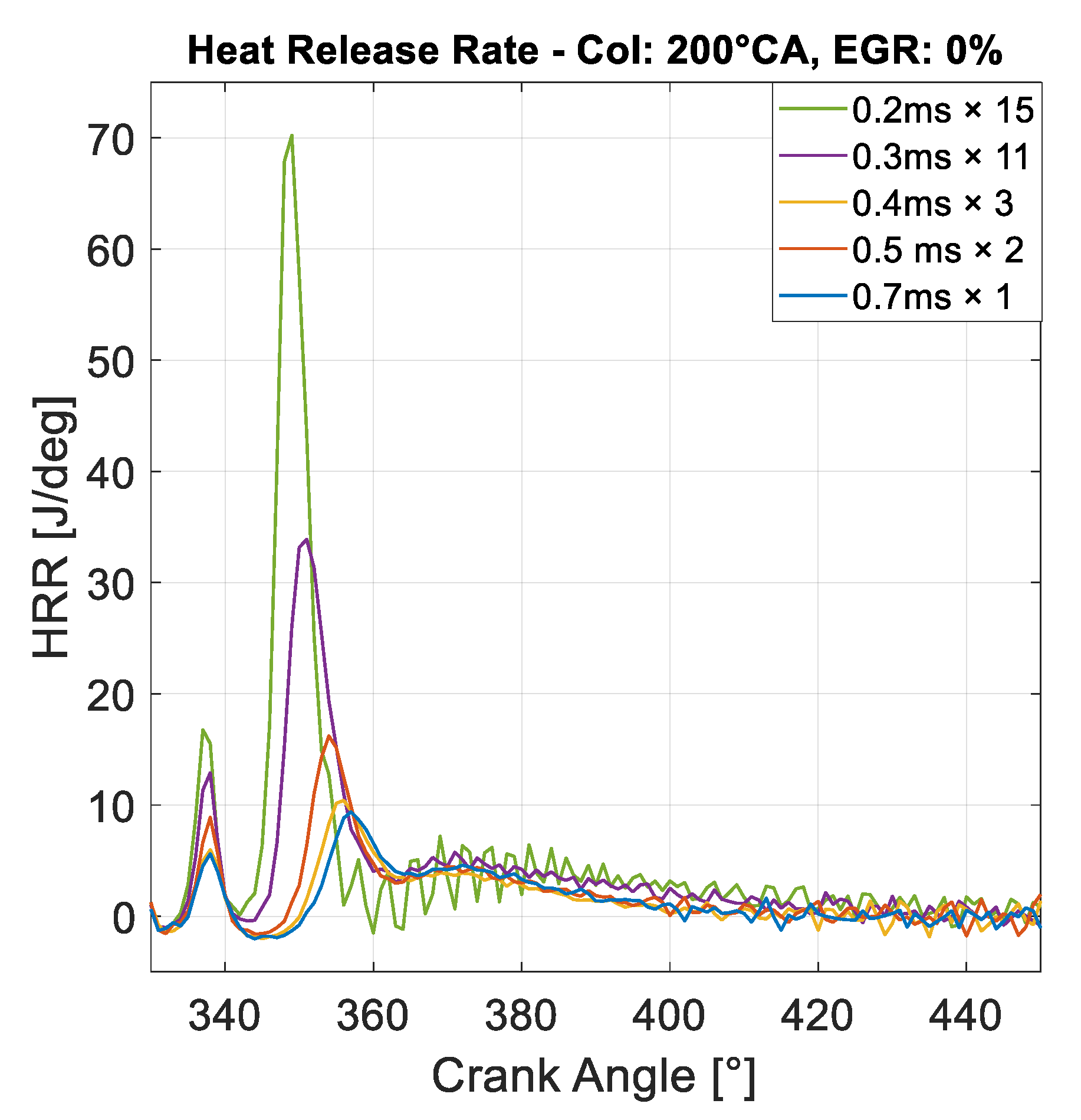
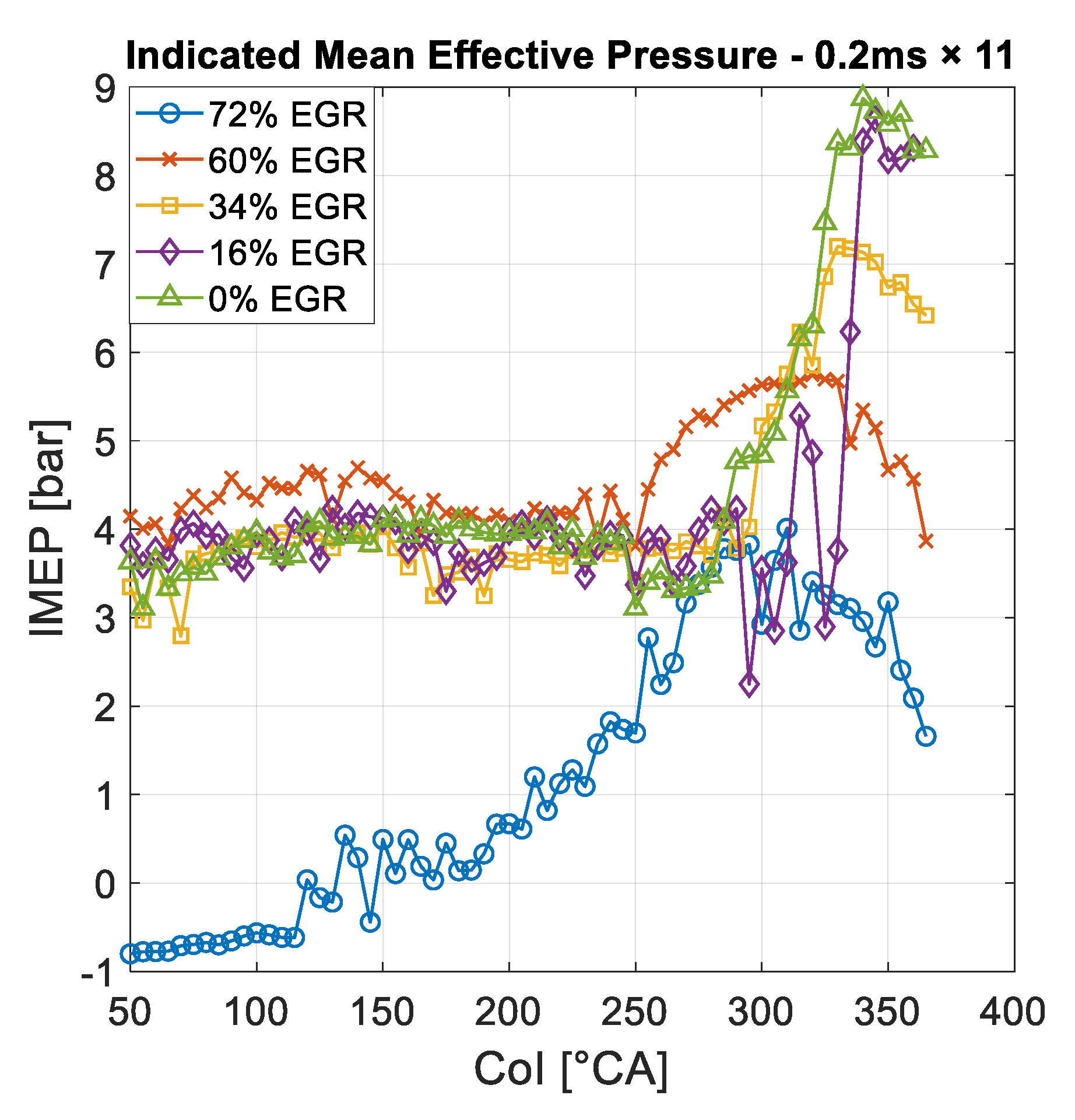
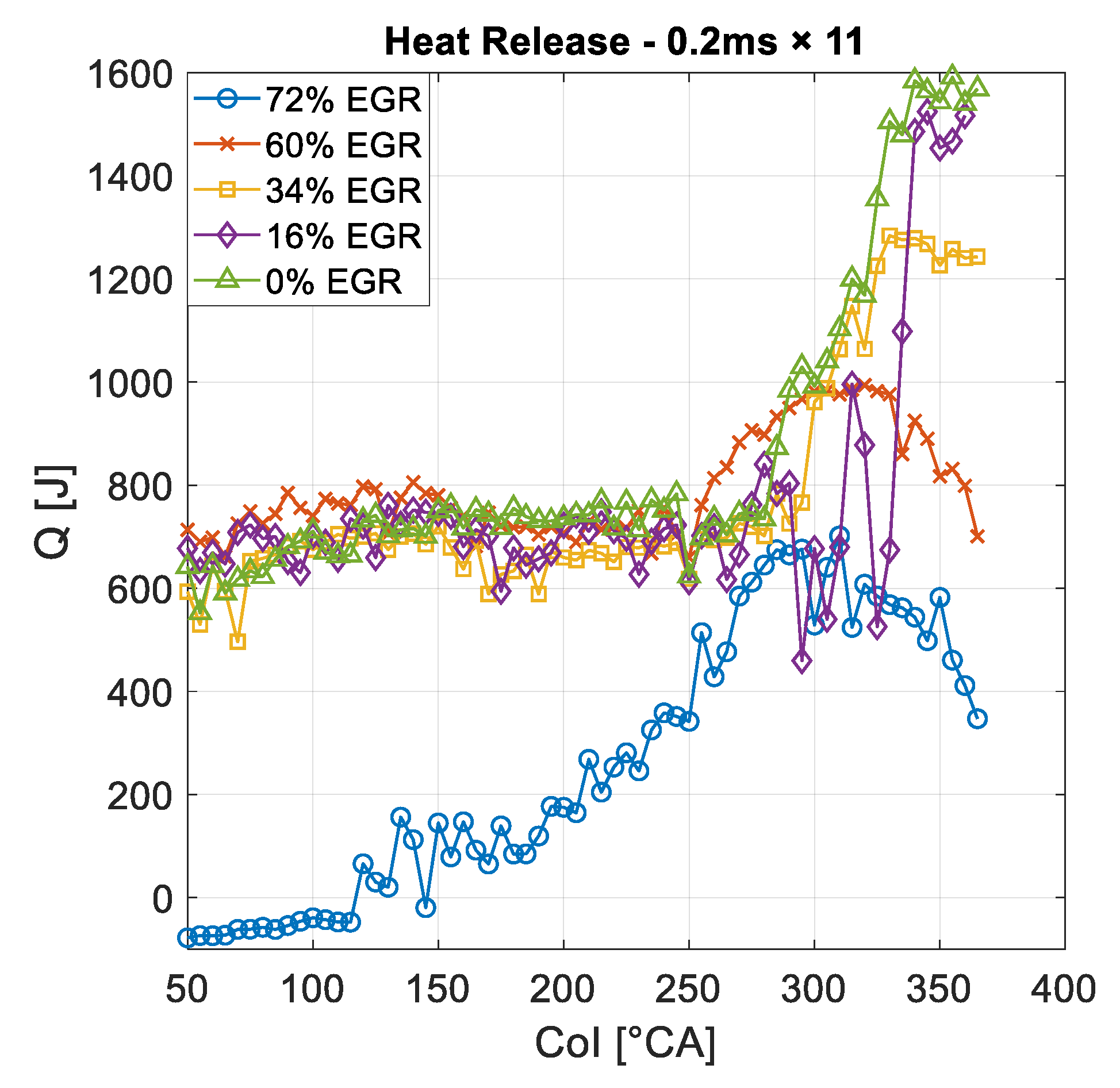
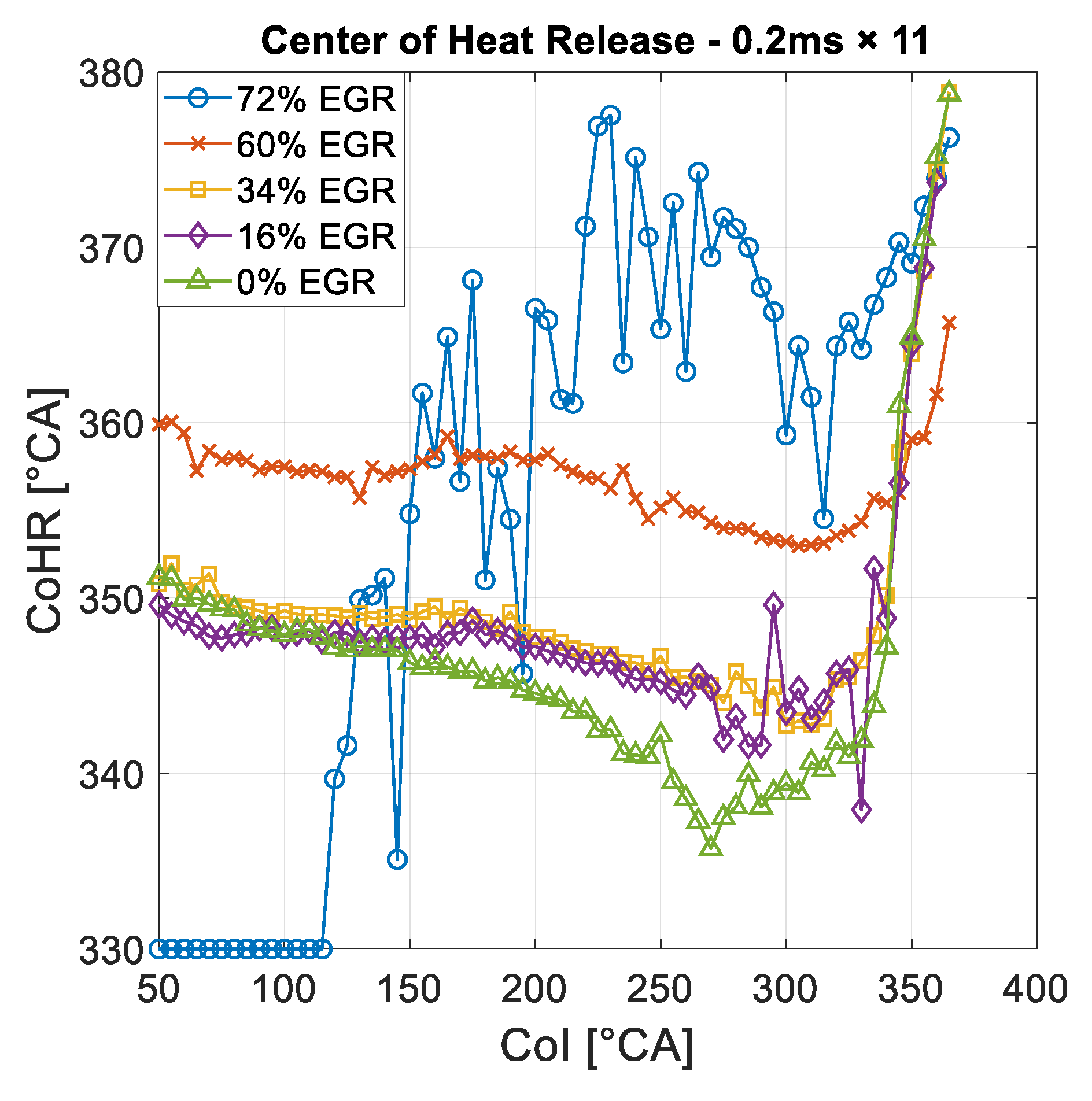
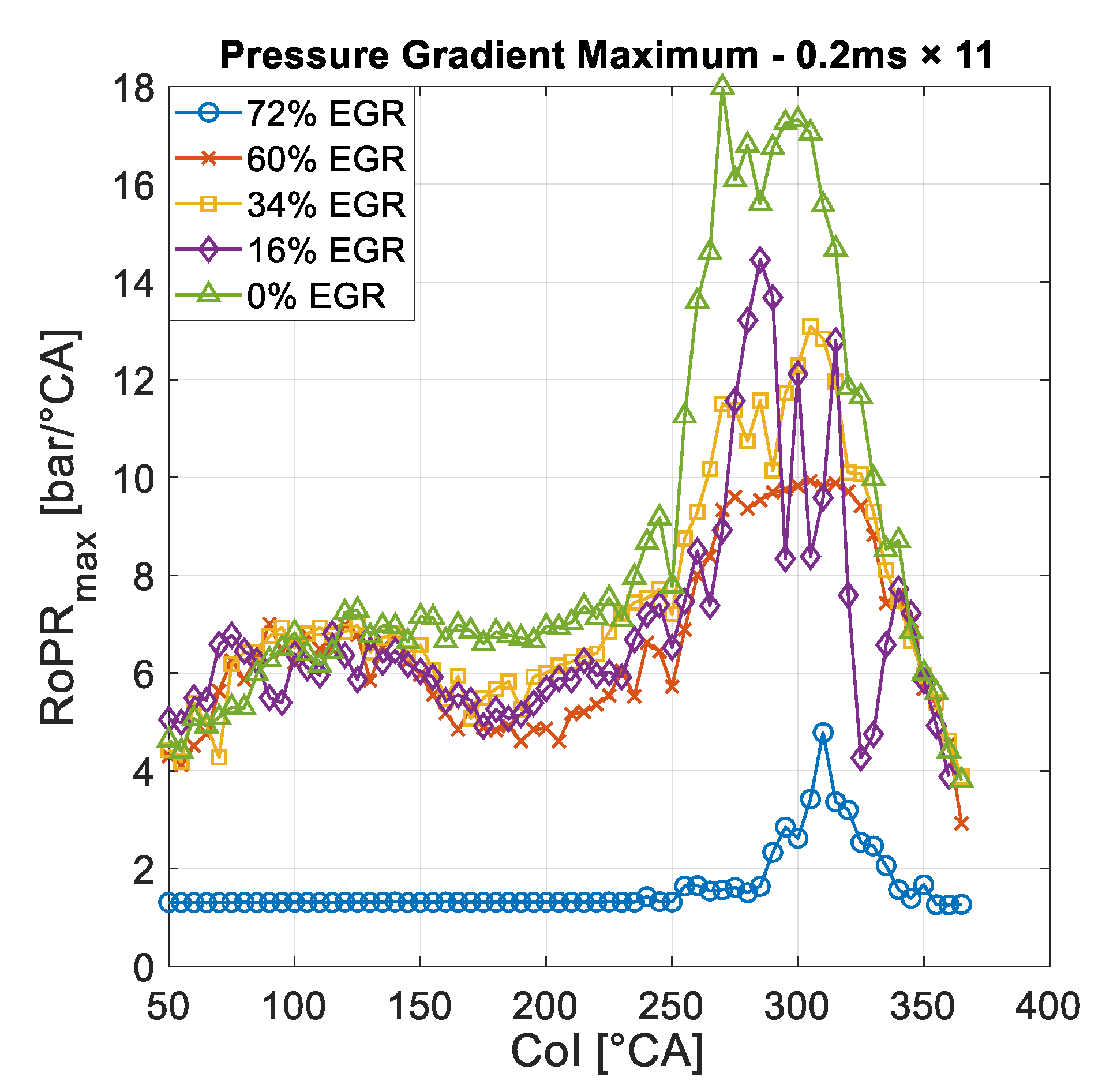
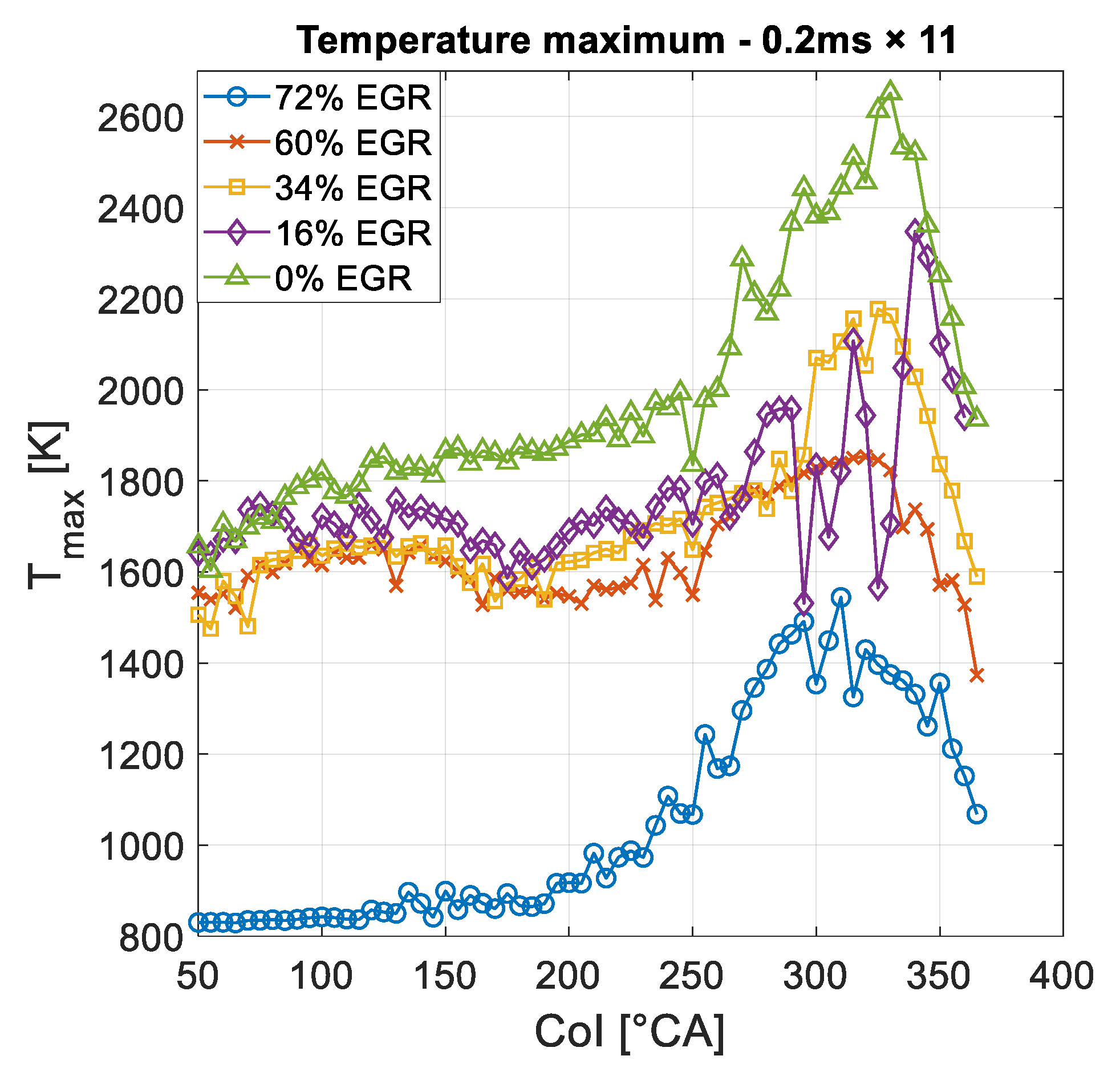
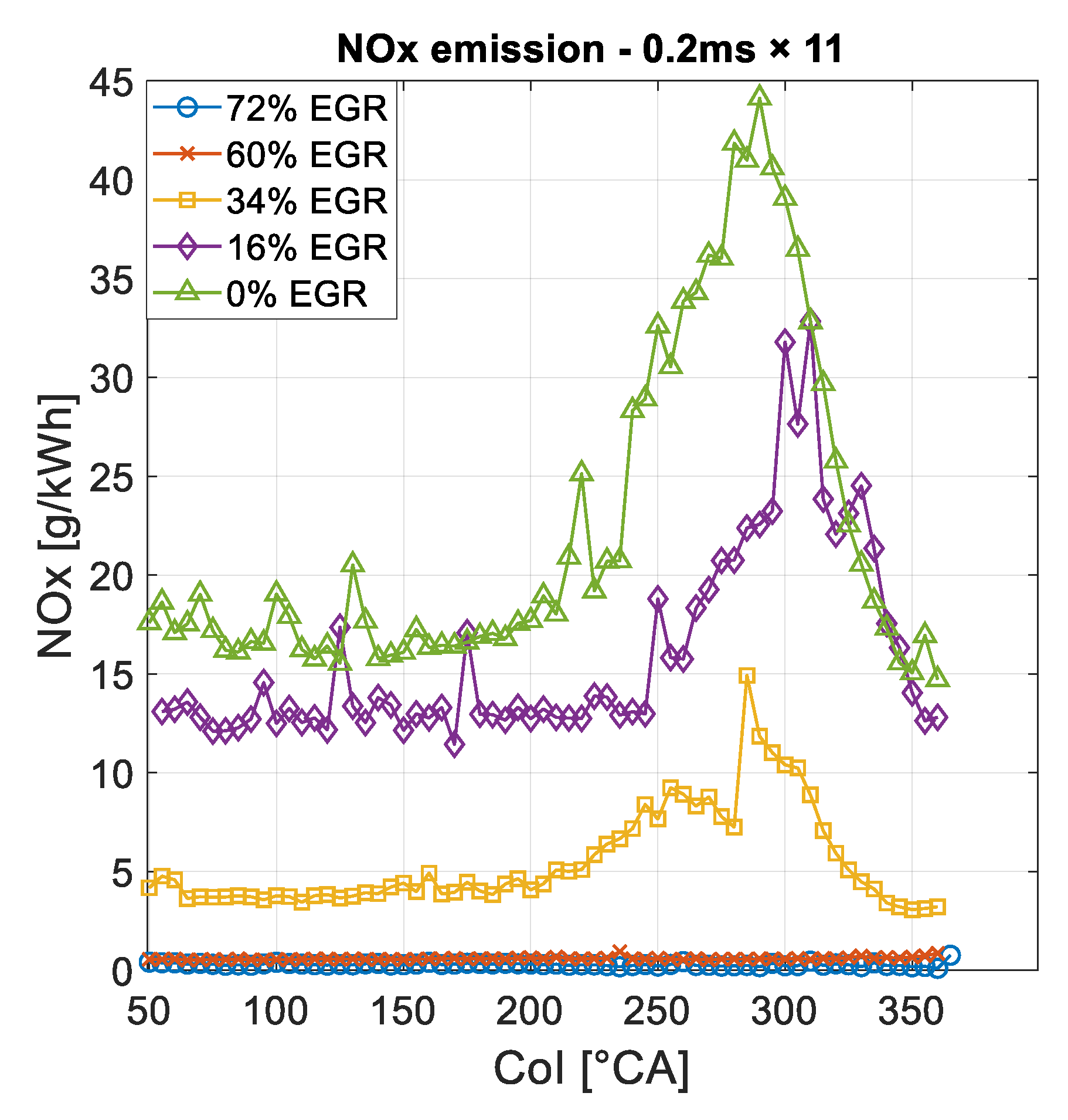
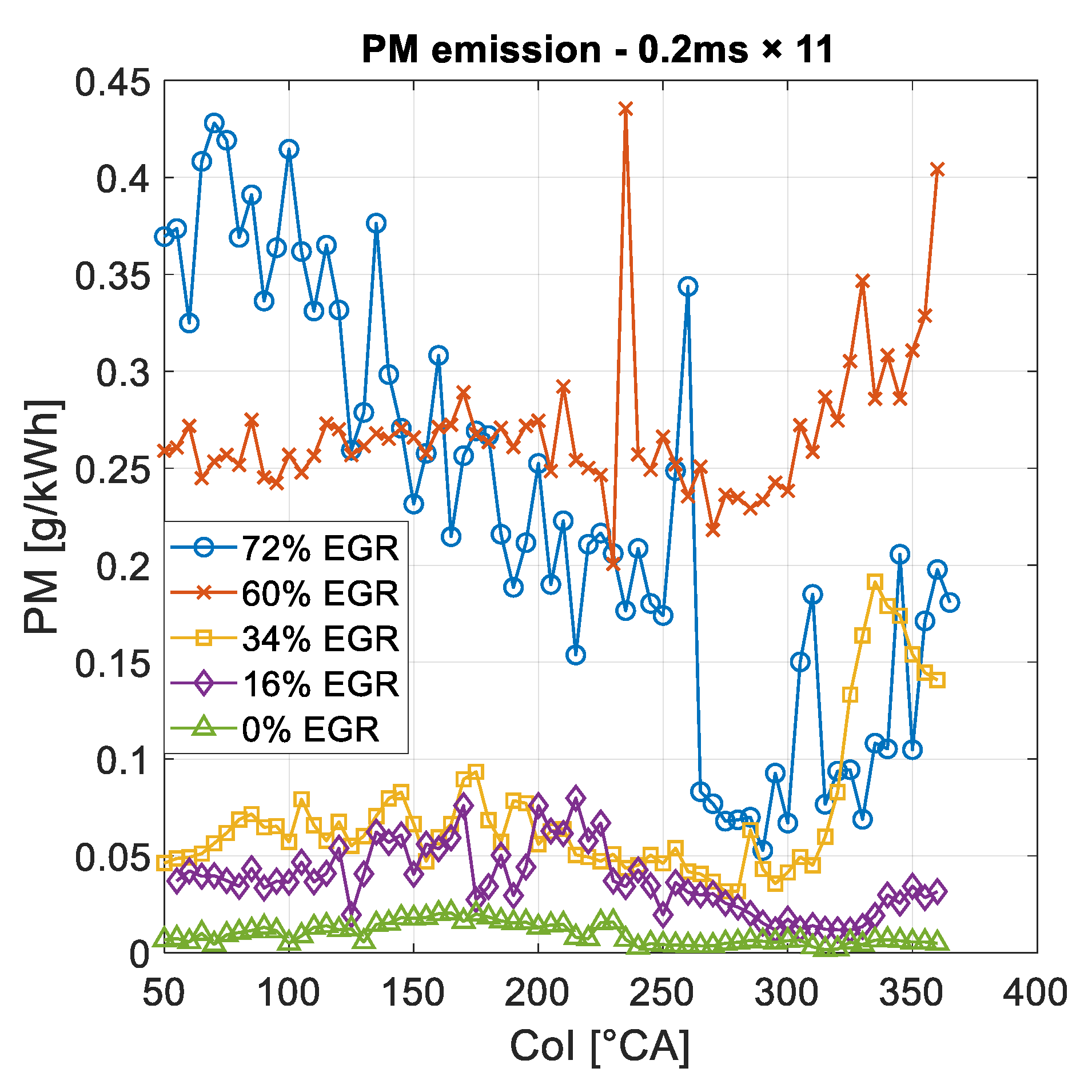
| Engine displacement | 3922 cm3 |
| Bore | 102 mm |
| Stroke | 120 mm |
| Compression ratio | 17.3 |
| Rated effective power | 125 kW |
| First Experiment | |||
|---|---|---|---|
| Load | 50 Nm (1250 rpm) | ||
| Dose | 27 mg | ||
| EGR | 0% | ||
| Structure Name | Single Injection Duration | Number of Injections | |
| 0.7 ms × 1 | 0.7 ms | 1 | |
| 0.5 ms × 2 | 0.5 ms | 2 | |
| 0.4 ms × 3 | 0.4 ms | 3 | |
| 0.3 ms × 11 | 0.3 ms | 11 | |
| 0.2 ms × 15 | 0.2 ms | 15 | |
| Second Experiment | |||||
|---|---|---|---|---|---|
| Load | 50 Nm (1250 rpm) | ||||
| Dose | 31 mg | ||||
| Structure Name | 0.2 ms × 11 | ||||
| EGR | 0% | 16% | 34% | 60% | 72% |
Publisher’s Note: MDPI stays neutral with regard to jurisdictional claims in published maps and institutional affiliations. |
© 2021 by the authors. Licensee MDPI, Basel, Switzerland. This article is an open access article distributed under the terms and conditions of the Creative Commons Attribution (CC BY) license (https://creativecommons.org/licenses/by/4.0/).
Share and Cite
Virt, M.; Granovitter, G.; Zöldy, M.; Bárdos, Á.; Nyerges, Á. Multipulse Ballistic Injection: A Novel Method for Improving Low Temperature Combustion with Early Injection Timings. Energies 2021, 14, 3727. https://doi.org/10.3390/en14133727
Virt M, Granovitter G, Zöldy M, Bárdos Á, Nyerges Á. Multipulse Ballistic Injection: A Novel Method for Improving Low Temperature Combustion with Early Injection Timings. Energies. 2021; 14(13):3727. https://doi.org/10.3390/en14133727
Chicago/Turabian StyleVirt, Márton, Gergely Granovitter, Máté Zöldy, Ádám Bárdos, and Ádám Nyerges. 2021. "Multipulse Ballistic Injection: A Novel Method for Improving Low Temperature Combustion with Early Injection Timings" Energies 14, no. 13: 3727. https://doi.org/10.3390/en14133727
APA StyleVirt, M., Granovitter, G., Zöldy, M., Bárdos, Á., & Nyerges, Á. (2021). Multipulse Ballistic Injection: A Novel Method for Improving Low Temperature Combustion with Early Injection Timings. Energies, 14(13), 3727. https://doi.org/10.3390/en14133727







